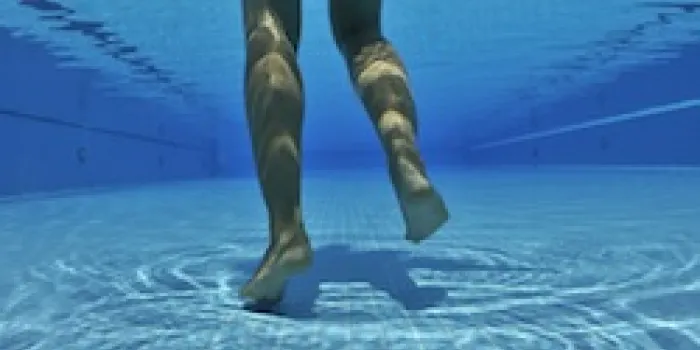In the past, people with bleeding disorders have been told to proceed with caution with some types of physical therapy because some health professionals thought movement could cause bleeding. Now, doctors and physical therapists give patients the green light for many types of therapies. They even encourage patients to engage in certain exercises—especially swimming—to build strength, prevent muscle wasting and reduce pain.
Therapy, whether aqua- or land-based, however, isn’t one-size-fits-all. People with bleeding disorders need to know what is appropriate for their symptoms, age and overall health, says Michael Uttecht, PT, MS, a physical therapist clinical leader at MedStar Georgetown University Hospital in Washington, D.C., a hemophilia treatment center.
“Aquatic therapy provides an excellent environment for an individual with advanced joint arthropathy (damage caused by internal bleeding) to exercise in safety,” Uttecht says. “However, this antigravity environment will only strengthen the body to a limit. If continued strengthening is the goal, then safe land-based exercises should be implemented.”
Pool Time
Grace Volsen, MPT, ATRIC, a physical therapist at Wenatchee Valley Medical Center in Washington, recommends aquatic therapy to all of her patients with bleeding disorders. She says the biggest benefit to working out in the pool is that the patient can offload about 65% of his body weight through the buoyancy of the water. That helps increase his strength and function, free up his range of motion, and reduce his swelling and pain, she says.
Further, aquatic therapy for patients with hemophilia positively affects motor performance and offers improved aerobic and mechanical capacity, according to a study published in Haemophilia in 2010. That’s good news for people with bleeding disorders, says John J. Strouse, MD, PhD, an assistant professor of pediatrics in the Division of Pediatric Hematology at Johns Hopkins University School of Medicine in Baltimore. “I am excited to see studies that provide support for exercise-based interventions, as exercise is essential for a healthy lifestyle and an important component of maintaining a healthy weight.”
The results of this research study support what clinicians have long been doing in practice. “Hemophilia providers have recommended water-based exercise and other low-impact activities for many years but with little evidence,” Strouse says. “This study shows a profound increase in aerobic capacity with aquatic exercise and significant but smaller improvements in the distance covered in 12 minutes (about a 15% increase or 200 meters).”
A variety of water depths and customized programs, which blend strength and aerobic activity, can help patients of all ages. However, certain individuals, including those with incontinence, skin disorders or allergies to certain water treatments, should avoid aqua therapy, Volsen says.
Aquatic therapy can also help people with bleeding disorders prepare for surgery, such as knee replacements. It teaches them strengthening exercises they can do before and after the operation, says Volsen. “Once a surgeon clears a patient for therapy, working against the water’s buoyancy is great for the ankles, knees, hips and shoulders.”
After attending a physical therapy program led by a credentialed instructor, patients are encouraged to continue exercising in the pool on their own. Warmer water, about 94 degrees, is ideal for aquatic therapy. Some YMCA or college pools may be an option for warm-water therapy.
Volsen says the optimal program for people with bleeding disorders combines water therapy with land-based therapy, which helps patients transfer their gains in the pool to land. “An aquatic environment gives the patient another opportunity to work on range of motion and strength. It translates to activities in daily living,” she says. “They have more strength for chores, for recreation and for work.”
Out of Water
While land-based therapy is an option for some people with bleeding disorders, others have conditions that might prevent them from trying it. “It’s not good for everyone, especially patients who are deconditioned, or weak, or overweight, or in poor health,” says Uttecht, who has been a physical therapist for 15 years. A pool environment is more supportive in those cases, he says.
The biggest drawback of land-based therapy is the amount of stress it places on the body. However, for the younger, healthier set, exercises on land build strength better, Uttecht says.Uttecht helps transition his patients to home programs, which cost at most the equivalent of a gym membership. That’s on average $42.55 per month, according to 2011 data from the International Health, Racquet & Sportsclub Association. This is the next step after meeting functional goals set in the beginning of physical therapy. Personal trainers usually are not recommended, though, because of their limited knowledge of bleeding disorders.
The exercises done in the gym or at home should be adapted individually for the patient, and for those who have chronic bleeding into target joints.
People with bleeding disorders need to be lifelong students of their condition, Uttecht says. “Life is a continuing learning process. We need to get smarter and see what’s appropriate at each stage of life.”
An aquatic environment only strengthens the body to a limit, Uttecht says. People with bleeding disorders should turn to safe land-based therapy if continued strengthening is the goal.
Learn More:
American Physical Therapy Association (Aquatic Physical Therapy Section)

